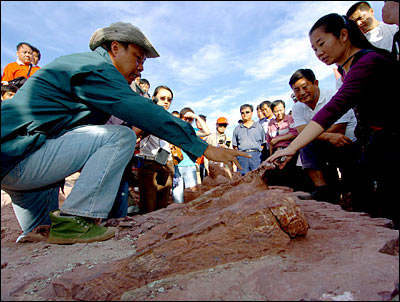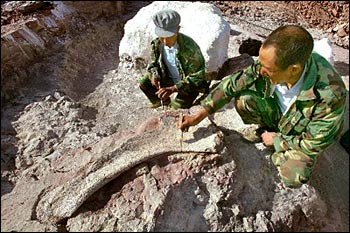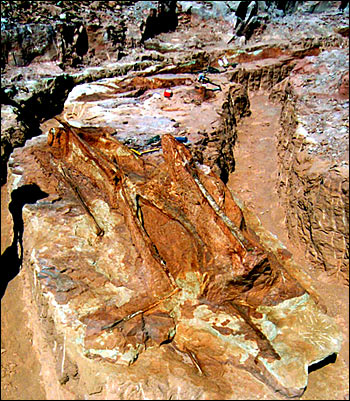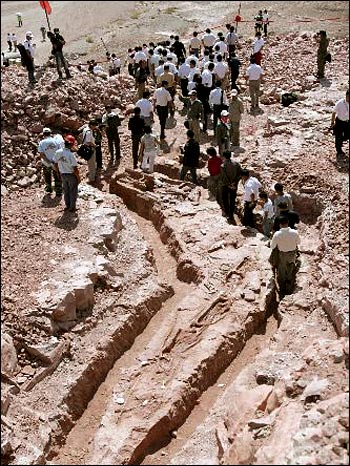| Tools: Save | Print | E-mail | Most Read |
| Fossils of New Dinosaur Species Unearthed in NW China |
| Adjust font size: |
A Muslim farmer in the Ningxia Hui Autonomous Region had never imagined in his wildest dreams that he could become the finder of a "national treasure", especially one whose excavation was televised live to all Chinese people by China Central Television (CCTV) on Saturday afternoon. Ma Yun had been catching hedgehogs on a hill near "I had guessed that," said the contented farmer, who was so excited to appear on TV that he cut his long hair. It was the first fossil excavation broadcast live in "We made this live broadcast because these fossils are so precious," said Xu Xing, 37-year-old archaeologist and researcher with the Eight sauropods, or huge, long-necked herbivorous dinosaurs living some 160 million years ago, were unearthed in a 3,000-square meter area in Lingwu, said Professor Xu. Twenty-eight teeth lay in order on the ground and Xu noted that a skull might be underneath. A 1.1-meter-long backbone has also been discovered, the biggest ever excavated in Professor Xu, who has personally named 15 new dinosaur species, believes that the dinosaur is a sub-species of diplodocus, mainly found in the southern hemisphere in places like Discovery of the species in The fossils could also help experts better understand geological changes in northwest China, as Xu noticed some bones had been washed away in this arid area. He believed that the spot might have been a delta millions of years ago. Sauropods were the Jurassic's finest specimens, growing up to 40 meters long and weighing over 100 tons. Questions are being raised over death of the mammoth creature. "It is rare to find so many dinosaurs, of varied sizes, dead together," said Mo Jinyou, professor with the The fossils will be preserved on the spot, where a museum shall be built, according to Wang Jun, vice director of Lingwu's Publicity Department. Meanwhile, a national geological park featuring wood and dinosaur fossils opened in Changji in Xinjiang on Saturday, where the largest dinosaur in The dinosaur, 35 meters in length, is five meters longer than Asia's previous largest, which was discovered by a Sino-Canadian archaeological team in 1987 and is displayed in the In 1902, At present, the amount of dinosaur fossils unearthed in Experts are asking the public to suggest names for the dinosaurs. Many people believed that the dinosaur in Lingwu should be named after the discoverer Ma Yun. While Ma Yun has named his son "Xiao Long", the name of a kind of dinosaur, he noted that his discovery was rather of the tall kind.
(Xinhua News Agency August 28, 2006) |
| Tools: Save | Print | E-mail | Most Read |
 |
| Related Stories |
| Product Directory China Search |
Country Search Hot Buys |



